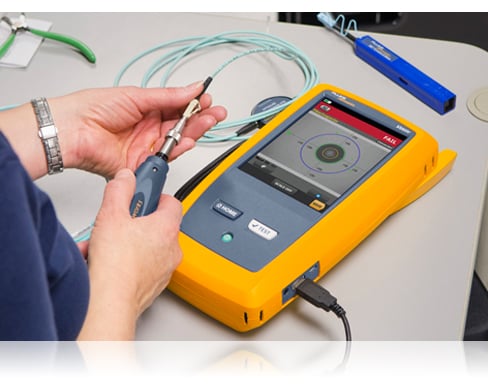Industries depend on fibre testing equipment to verify product reliability.
Exploring the Benefits of Optical Fibre Evaluating for Improved Interaction Solutions
The importance of optical fiber testing in contemporary communication systems can not be overstated, as it serves as a structure for making certain network integrity and efficiency. Utilizing innovative methods such as Optical Time-Domain Reflectometry (OTDR) and insertion loss analysis, companies can not only recognize faults but likewise maximize their arrangements. This positive screening strategy has extensive ramifications for signal quality and functional efficiency, increasing the question of just how these methods add to long-term sustainability in an ever-evolving technological landscape. Recognizing these characteristics is necessary for stakeholders intending to preserve a competitive side.
Value of Optical Fibre Testing
The value of optical fibre testing can not be overemphasized in today's data-driven environment. As organizations progressively rely upon high-speed data transmission for day-to-day operations, the honesty and performance of optical fiber networks are paramount. Checking makes certain that these networks can sustain the substantial amounts of information generated and transmitted seamlessly, fostering reliable communication and connection.
Optical fiber screening serves numerous crucial features, including validating installment quality, recognizing prospective faults, and identifying general system efficiency. Normal testing can stop pricey downtimes and service interruptions, enabling companies to keep operational continuity. Moreover, it helps in conformity with sector criteria and regulations, guaranteeing that fibre optic installments meet needed requirements for security and reliability.
Furthermore, testing can enhance the durability of fibre optic systems. By proactively determining concerns such as signal loss, depletion, or port failures, organizations can resolve issues prior to they intensify, hence expanding the life of their facilities. In recap, optical fiber screening is not merely a technological demand yet a tactical investment that improves network reliability, maximizes performance, and inevitably supports the growth and performance of modern interaction systems.
Secret Testing Techniques

OTDR is a crucial method used to recognize faults, step splice losses, and examine the total honesty of a fiber optic link. By sending out a pulse of light down the fiber and evaluating the mirrored light, professionals can determine locations of faults and assess the network's efficiency over cross countries.
Insertion loss testing measures the amount of signal loss that occurs when light travel through a connection or splice. This approach is critical for confirming that connections fulfill given loss thresholds, which is necessary for maintaining ideal performance in communication systems.
Optical return loss testing quantifies the quantity of light reflected back in the direction of the resource because of flaws in the fibre or connections. High return loss values indicate better efficiency and minimized signal deterioration.
Together, these testing techniques provide an extensive analysis of fibre optic networks, guaranteeing their integrity and capability in varied communication applications.
Influence on System Efficiency
Efficient optical fibre testing directly influences the general performance of communication systems. By making certain the stability of fibre optic cords, testing recognizes potential mistakes such as attenuation, splice loss, and connector misalignment. These problems can significantly degrade signal top quality, causing disturbances and lowered information transmission speeds.
In addition, normal optical fibre testing adds to long-term system sustainability. It enables early discovery of deterioration, permitting prompt upkeep and upgrades before significant failures occur. This not just prolongs the life-span of the infrastructure yet likewise makes certain that interaction systems stay affordable in regards to efficiency.
Cost-Effectiveness and Efficiency
Cost-effectiveness is an important factor to consider in the deployment and upkeep of optical fibre networks. Applying robust optical fibre testing procedures can dramatically minimize operational costs by determining concerns prior to they rise into major issues. optical fibre diameter analyser. By discovering mistakes, attenuation, and various other performance limitations early, organizations can stay clear of expensive repairs and downtime, which can interfere with services and lead to income loss
Furthermore, reliable screening approaches simplify the installment procedure, allowing service technicians to function better. This converts to decrease labour costs and faster task conclusion times. Advanced screening tools, such as Optical Time Domain Reflectometers (OTDRs), makes it possible for an exact analysis of fibre quality, making sure that only optimal materials are used, thereby reducing waste.
Normal screening additionally adds to much better resource allotment. By visit our website comprehending the network's efficiency, organizations can make enlightened decisions about upgrades and expansions, ensuring that investments are made where they are most needed. In recap, optical fibre testing boosts cost-effectiveness and efficiency, supporting the lasting sustainability and competitiveness of interaction systems in an increasingly demanding market.
Making Certain Long-Term Integrity
Carrying out strenuous optical fibre screening not just improves price savings and functional performance however also plays a pivotal duty in ensuring the long-lasting dependability of interaction networks. Constant testing techniques, including depletion and transmission capacity evaluations, assistance determine potential deterioration in fibre efficiency before it leads to solution disruptions.
By using sophisticated screening methodologies, network drivers can pinpoint faults or weak points in the fiber infrastructure, enabling timely removal. This positive technique minimizes downtime, making certain that interaction systems stay useful and reliable. Furthermore, routine screening adds to the development of an extra resistant network, as operators can adjust and enhance their facilities based upon real-time information insights. optical fibre diameter analyser.
In addition, here are the findings guaranteeing conformity with industry requirements with optical fibre screening enhances the top quality and integrity of the whole interaction system. This adherence not just bolsters self-confidence among stakeholders however likewise aligns with regulatory demands, which are progressively rigorous.
Conclusion
In conclusion, optical fiber screening serves as a basic part in boosting communication systems. By using numerous testing methods, such as OTDR and insertion loss analyses, networks can achieve optimum efficiency and reliability. The aggressive recognition of faults not just improves signal high quality however additionally reduces downtime, inevitably contributing to cost-effectiveness and operational effectiveness. In addition, adherence to industry standards cultivates stakeholder self-confidence, guaranteeing the long-term sustainability of interaction frameworks in a significantly data-driven landscape.